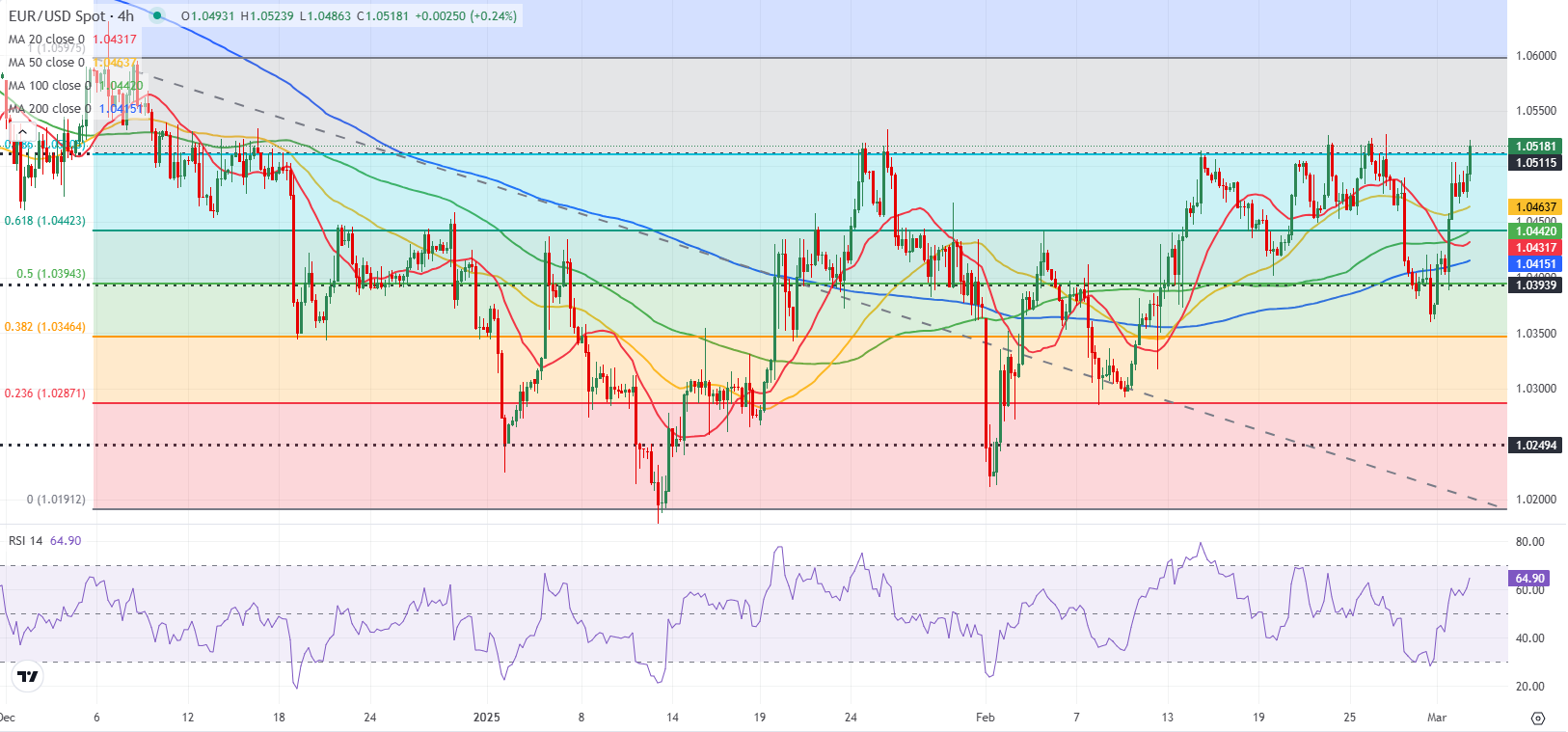- EUR/USD trades above 1.0500 in the European morning on Tuesday.
- US President Trump's tariffs took effect early Tuesday, triggering retaliatory responses.
- The US economic calendar will not feature any high-tier data releases.
After ending the previous week on a bearish note, EUR/USD gained traction on Monday and rose more than 1% on the day. The pair continues to edge higher in the European session on Tuesday and trades above 1.0500.
Euro PRICE This week
The table below shows the percentage change of Euro (EUR) against listed major currencies this week. Euro was the strongest against the US Dollar.
| USD | EUR | GBP | JPY | CAD | AUD | NZD | CHF | |
|---|---|---|---|---|---|---|---|---|
| USD | -1.35% | -1.10% | -0.98% | 0.00% | -0.07% | -0.38% | -1.15% | |
| EUR | 1.35% | 0.14% | 0.16% | 1.18% | 1.20% | 0.79% | 0.02% | |
| GBP | 1.10% | -0.14% | 0.13% | 1.04% | 1.06% | 0.66% | -0.12% | |
| JPY | 0.98% | -0.16% | -0.13% | 1.20% | 0.96% | 0.64% | -0.18% | |
| CAD | -0.00% | -1.18% | -1.04% | -1.20% | 0.08% | -0.38% | -1.15% | |
| AUD | 0.07% | -1.20% | -1.06% | -0.96% | -0.08% | -0.40% | -1.17% | |
| NZD | 0.38% | -0.79% | -0.66% | -0.64% | 0.38% | 0.40% | -0.77% | |
| CHF | 1.15% | -0.02% | 0.12% | 0.18% | 1.15% | 1.17% | 0.77% |
The heat map shows percentage changes of major currencies against each other. The base currency is picked from the left column, while the quote currency is picked from the top row. For example, if you pick the Euro from the left column and move along the horizontal line to the US Dollar, the percentage change displayed in the box will represent EUR (base)/USD (quote).
The disappointing ISM Manufacturing Purchasing Managers Index (PMI) data from the US weighed on the US Dollar (USD) in the American session on Monday. The headline PMI declined to 50.3 in February from 50.9 in January, reflecting a loss of growth momentum in the manufacturing sector's business activity. Additionally, the Employment Index slumped to 47.6 from 50.3 and showed a contraction in the sector's payrolls. Other data from the US showed that Construction Spending declined by 0.2% on a monthly basis in January.
Following these data releases, The Federal Reserve Bank of Atlanta revised its Gross Domestic Product (GDP) projection in its GDPNow report to -2.8% for the first quarter from -1.5% on February 28. "After this morning’s releases from the US Census Bureau and the Institute for Supply Management, the nowcast of first-quarter real personal consumption expenditures growth and real private fixed investment growth fell from 1.3% and 3.5%, respectively, to 0.0% and 0.1%," the publication read.
In the meantime, US President Donald Trump's 25% tariffs on Canadian and Mexican imports, as well as the additional 10% on Chinese goods, went into effect early Tuesday. In response, Canada and China announced retaliatory measures, further feeding into concerns over an economic downturn in the US. As a result, the USD came under pressure, Wall Street's main indexes declined sharply and the benchmark 10-year US Treasury bond yield dropped to its weakest level since early December below 4.2%.
The economic calendar will not feature any high-tier data releases on Tuesday. Following these developments, markets could refrain from betting on a steady recovery in the USD. In case the Trump administration takes a step back in the tariff policy and opens the door to negotiations with trade partners, the USD could rebound on easing fears over a recession.
EUR/USD Technical Analysis
The Relative Strength Index (RSI) indicator on the 4-hour chart climbed above 60, reflecting a buildup of bullish momentum. EUR/USD was last seen trading slightly above 1.0500-1.0520 (Fibonacci 78.6% retracement of the latest downtrend, 100-day Simple Moving Average (SMA), static level). In case the pair confirms this area as support, 1.0550 (static level) could be seen as interim resistance ahead of 1.0600 (static level, beginning point of the downtrend).
On the downside, supports could be seen at 1.0440-1.0435 (Fibonacci 61.8% retracement, 20-day SMA) and 1.0400-1.0410 (200-period SMA, Fibonacci 50% retracement).
Euro FAQs
The Euro is the currency for the 19 European Union countries that belong to the Eurozone. It is the second most heavily traded currency in the world behind the US Dollar. In 2022, it accounted for 31% of all foreign exchange transactions, with an average daily turnover of over $2.2 trillion a day. EUR/USD is the most heavily traded currency pair in the world, accounting for an estimated 30% off all transactions, followed by EUR/JPY (4%), EUR/GBP (3%) and EUR/AUD (2%).
The European Central Bank (ECB) in Frankfurt, Germany, is the reserve bank for the Eurozone. The ECB sets interest rates and manages monetary policy. The ECB’s primary mandate is to maintain price stability, which means either controlling inflation or stimulating growth. Its primary tool is the raising or lowering of interest rates. Relatively high interest rates – or the expectation of higher rates – will usually benefit the Euro and vice versa. The ECB Governing Council makes monetary policy decisions at meetings held eight times a year. Decisions are made by heads of the Eurozone national banks and six permanent members, including the President of the ECB, Christine Lagarde.
Eurozone inflation data, measured by the Harmonized Index of Consumer Prices (HICP), is an important econometric for the Euro. If inflation rises more than expected, especially if above the ECB’s 2% target, it obliges the ECB to raise interest rates to bring it back under control. Relatively high interest rates compared to its counterparts will usually benefit the Euro, as it makes the region more attractive as a place for global investors to park their money.
Data releases gauge the health of the economy and can impact on the Euro. Indicators such as GDP, Manufacturing and Services PMIs, employment, and consumer sentiment surveys can all influence the direction of the single currency. A strong economy is good for the Euro. Not only does it attract more foreign investment but it may encourage the ECB to put up interest rates, which will directly strengthen the Euro. Otherwise, if economic data is weak, the Euro is likely to fall. Economic data for the four largest economies in the euro area (Germany, France, Italy and Spain) are especially significant, as they account for 75% of the Eurozone’s economy.
Another significant data release for the Euro is the Trade Balance. This indicator measures the difference between what a country earns from its exports and what it spends on imports over a given period. If a country produces highly sought after exports then its currency will gain in value purely from the extra demand created from foreign buyers seeking to purchase these goods. Therefore, a positive net Trade Balance strengthens a currency and vice versa for a negative balance.
Information on these pages contains forward-looking statements that involve risks and uncertainties. Markets and instruments profiled on this page are for informational purposes only and should not in any way come across as a recommendation to buy or sell in these assets. You should do your own thorough research before making any investment decisions. FXStreet does not in any way guarantee that this information is free from mistakes, errors, or material misstatements. It also does not guarantee that this information is of a timely nature. Investing in Open Markets involves a great deal of risk, including the loss of all or a portion of your investment, as well as emotional distress. All risks, losses and costs associated with investing, including total loss of principal, are your responsibility. The views and opinions expressed in this article are those of the authors and do not necessarily reflect the official policy or position of FXStreet nor its advertisers. The author will not be held responsible for information that is found at the end of links posted on this page.
If not otherwise explicitly mentioned in the body of the article, at the time of writing, the author has no position in any stock mentioned in this article and no business relationship with any company mentioned. The author has not received compensation for writing this article, other than from FXStreet.
FXStreet and the author do not provide personalized recommendations. The author makes no representations as to the accuracy, completeness, or suitability of this information. FXStreet and the author will not be liable for any errors, omissions or any losses, injuries or damages arising from this information and its display or use. Errors and omissions excepted.
The author and FXStreet are not registered investment advisors and nothing in this article is intended to be investment advice.
Recommended Content
Editors’ Picks

EUR/USD remains offered in the low-1.0900s
The generalised selling pressure continues to weigh on the risk complex, pushing EUR/USD back toward the 1.0900 support level amid a growing risk-off mood, as traders assess President Trump’s reciprocal tariffs and their impact on economic activity.

GBP/USD retreats further and breaks below 1.2800
The US Dollar is picking up extra pace and flirting with daily highs, sending GBP/USD to multi-week lows near 1.2770 in a context where safe-haven demand continues to dictate sentiment amid the chaos of US tariffs.

Gold slips back below the $3,000 mark
Gold has turned lower, slipping beneath the key $3,000 mark per troy ounce amid a broad sell-off across global equity markets. The decline in the precious metal may reflect investors unwinding long positions in gold to offset mounting losses in stocks.

US stock market suddenly reverses higher after rumor of 90-day tariff pause before sinking again Premium
NASDAQ sinks 4% before shooting higher on tariff pause rumor. CNBC says White House unaware of tariff pause rumor. S&P 500 sinks to January 2024 level. Bank of America cuts its year-end target for S&P 500 by 16%.

Strategic implications of “Liberation Day”
Liberation Day in the United States came with extremely protectionist and inward-looking tariff policy aimed at just about all U.S. trading partners. In this report, we outline some of the more strategic implications of Liberation Day and developments we will be paying close attention to going forward.

The Best brokers to trade EUR/USD
SPONSORED Discover the top brokers for trading EUR/USD in 2025. Our list features brokers with competitive spreads, fast execution, and powerful platforms. Whether you're a beginner or an expert, find the right partner to navigate the dynamic Forex market.
